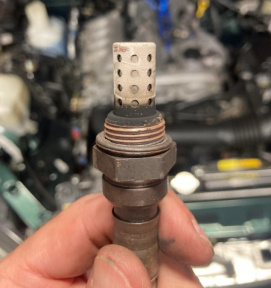
The oxygen sensor has the task of providing the engine control unit with information about the residual oxygen content in the exhaust gases. If this sensor malfunctions, fuel consumption can increase by up to 50%. In modern vehicles, not just one, but several oxygen sensors are used (before and after the catalytic converter).
Oxygen Sensor - What Is It Used For?
The exhaust gases produced during combustion first reach the oxygen sensor before the catalytic converter (also known as the control sensor), which measures the residual oxygen content of the exhaust gases and sends this information to the engine control unit. Based on this data, the control unit determines the optimal air-fuel ratio. The optimal ratio is 1:14.7 – 14.7 pounds (6.67 kg) of air are needed to burn 1 pound (0.45 kg) of fuel (stoichiometric ratio). Using the oxygen sensor, the engine control unit can constantly adjust the mixture to maintain this ratio.
An air-fuel ratio greater than 1:14.7 means that there is too much air (lean mixture). In this case, the control unit increases the amount of fuel injected. If the ratio is below the optimal value, it indicates a rich mixture, i.e., too much fuel is being injected. The combustion of such a mixture leads to an increase in hydrocarbon and carbon monoxide emissions.
Behind the catalytic converter, there is another oxygen sensor (diagnostic sensor), which also monitors the condition of the exhaust gases leaving the catalytic converter. These gases should not contain any oxygen. If they do, it could indicate a problem with the catalytic converter. Identical readings from both oxygen sensors are a sign that the catalytic converter is completely worn out and no longer functioning properly.
Symptoms of a Bad Oxygen Sensor

Like any other component, the oxygen sensor is susceptible to defects. The most common symptoms of a defective oxygen sensor include:
- Increased fuel consumption;
- Black smoke coming from the exhaust pipe;
- Reduced engine performance;
- Lit engine control light;
See Also:
Same articles

Understanding Vehicle Inspection and Verification Services: Why They Matter for Every Driver
GuidesVehicle inspection and verification services are an essential but often overlooked part of keeping roads safe and cars legally compliant. Most people only think about inspections when it’s...

Anonymous Cryptocurrency Exchange: Unlocking Confidential, Flexible Crypto Trading in 2025
GuidesThe concept of an "anonymous cryptocurrency exchange" has become a focal point in the digital asset world as privacy, user autonomy, and security have...

Renting a Car: What Do You Need to Know
GuidesEmbarking on the journey of renting a car for the first time can be akin to navigating uncharted waters. It's a path many have traversed, driven by the need for convenience, exploration, or...

